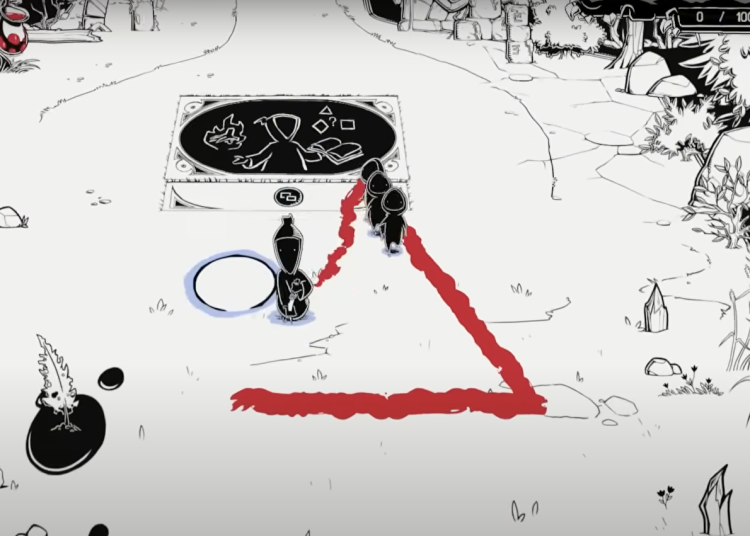Worship: Pikmin Meets Blood Rituals in Roguelike Form
Worship comes out July 16. You play as a cult leader devoted to a god of annihilation, recruiting followers, spilling blood, and crushing enemies in a twisted, Pikmin-like roguelike that’s all about rituals, sacrifice, and unholy power. It looks good, plays smart, and wants you to feel a little guilty about everything.
The Worship demo throws you straight into the robes of a newly minted cult leader, pledging allegiance to An-Ansgaidh, an ancient god who sees ending existence as the ultimate act of mercy. There’s no slow build or gentle onboarding—just a quick tutorial, a sassy talking grimoire, and then you’re bleeding on the ground to draw magic symbols and convert the godless.
You don’t start with any followers. That’s a problem for a cult leader, but it’s quickly solved. The conversion method? Cut your hand, bleed onto the ground, and form sacred shapes that pull nearby godless into your growing flock. Each symbol—circle, square, triangle—represents a different spell or command. The system looks simple, but it becomes a layered ritual language you’ll use constantly, even under pressure.
It costs you health to perform magic with your own blood, so early on, you’re fragile. The world is dangerous. Not all enemies can be converted. Some, like rapier-wielding zealots and bile-spewing horrors, are out for blood. But once you’ve built up enough followers, the game becomes about positioning, timing, and targeting. You mark an enemy, and your cult rushes in like a wave.

Combat is swarming-based and feels like a reverse tower defense. Your body count goes up fast, but they’re not mindless. Cultists can fall unconscious and get back up. They can be picked up and used as tools—thrown at bells, gutted for rituals, or sacrificed for a more powerful spell effect. But killing them has a cost: fewer bodies means a weaker army, and it never feels good to burn through your own.
“I don’t like killing the cultists. Partially because it leaves me with one less cultist, making my unholy army a little weaker. But partly because it doesn’t feel right. I brought them into this.”
Blood is a central resource, and the game doesn’t shy away from showing where it comes from. You can reclaim blood from fallen cultists, botched rituals, plants, stones, and fountains. Even when your magic fails, the fluid never goes to waste. It's a cycle of death, harvest, and invocation, and it's all painted in sharp black-and-white visuals that highlight just how grim your mission is.
As you complete combat encounters and tribute rituals, you gain access to chests containing relics, catalysts, and fountains. Catalysts unlock new abilities and passive perks—like being able to throw cultists farther, or cast blood-based spells more efficiently. The stronger your cult, the stronger you become. But without your followers, you’re weak. Magic takes time. Combat doesn’t.
There’s worldbuilding tucked into the game, too. You might stumble on a ghost town frozen mid-ritual because its musicians played the wrong song on bone-crafted instruments. Your job is to find the players and finish the rite. The music that follows is haunting and memorable. Worship’s atmosphere relies on sound design and stark contrast visuals. Good and evil are represented in extreme black and white, both literally and symbolically. It works.
Eventually, the demo takes you to the gates of The Last Church, a mysterious place your grimoire has blamed for everything so far. There, you meet Ulmira and Eleanor—one a woman in white, the other a monster with a doll. Your god commands you to kill them.
You can't hurt Eleanor directly. She stuns and burns your cultists when they get close. Her doll chases you around the map. Ulmira, however, is vulnerable. When you attack her, Eleanor jumps in to shield her. That’s your opening. Chip away at Ulmira to bait Eleanor into harm’s way. Dozens of followers die. Eventually, Eleanor falls. Ulmira cradles her body, sobbing. And that’s where the demo ends.
“Winning shouldn’t feel good. And I am glad Worship understands that.”
Worship’s biggest strength might be how clearly it understands its own themes. The art and music pull you in. The rituals and combat are satisfying. But the real hook is how the game frames your role as a cult leader. You’re powerful, but never heroic. Your cause is devotion to annihilation. The more you win, the more disturbing it becomes. And that’s the point.
Worship launches July 16 for PC. If you want something that plays like Pikmin, thinks like a roguelike, and bleeds like a horror film, this one might be worth watching.

Comments